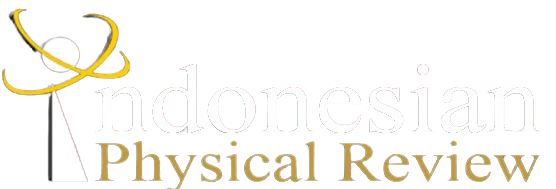SYNTHESIS AND CHARACTERIZATION OF PANI/PVA NANOFIBERS WITH VARIATION OF NOZZLE TO COLLECTOR DISTANCE USING ELECTROSPINNING METHOD
DOI:
10.29303/ipr.v5i3.151Downloads
Abstract
FTIR confirmed fumaric acid doped polyaniline as a polyaniline emeraldine salt phase. This study aims to determine the value of the electrical conductivity of PANI/PVA with variation in the distance of the needle to the collector, namely 11 cm, 13 cm, 15 cm, and 17 cm. The electrospinning method was carried out on a PANI/PVA solution to form polyaniline nanofibers. The electrospinning solution used a percent ratio of 1:1 PANI/PVA (10%). The morphological and fiber properties were characterized using FTIR, optical microscope, and SEM-EDX. The number of threads decreases and becomes more delicate as the distance increases due to the evaporation of PVA. The diameter of PANI/PVA fiber and pure PVA fiber is 236 nm and 256 nm. The PVA fiber diameter is slightly larger thane PANI/PVA fiber. Electrical conductivity was carried out using the four-point probe method. The electrical conductivity of the PANI/PVA sample is 1.39 × 10-6 S/cm at a distance of 15 cm with the best fiber shape.
Â
Â
Keywords:
electrical conductivity; electrospinning; PANI; PVAReferences
M. R. Gizdavic-Nikolaidis et al., “High yield and facile microwave-assisted synthesis of conductive H2SO4 doped polyanilines,†Mater. Chem. Phys., vol. 173, pp. 255–261, 2016, doi: 10.1016/j.matchemphys.2016.02.011.
M. F. Chairunnisyah, “Polimerisasi Interfasial Polianilin dan Aplikasinya sebagai Indikator Boraks,†2014.
I. Rahayu, D. R. Eddy, A. R. Noviyanti, and S. Hidayat, “Chimica et Natura Acta Peningkatan Konduktivitas Baterai Litium Besi Fosfat Dengan Polianilina,†vol. 6, no. 3, pp. 106–110, 2018.
A. B. Hamid, N. Sholichah, V. Rahayu, A. Ardimas, and U. M. Fadhli, “SINTESIS KOMPOSIT NANO PANI/Fe3O4 KONDUKTIF BERBASIS PASIR ALAM,†Indones. Phys. Rev., vol. 4, no. 2, p. 58, May 2021, doi: 10.29303/ipr.v4i2.94.
D. F. Nisa and N. P. Putri, “SINTESIS LAPISAN TIPIS SOLUBLE PANi DOPAN FUMARIC ACID DAN KARAKTERISTIKNYA,†Inov. Fis. Indones., vol. 10, no. 3, pp. 15–23, 2021.
R. F. Wulandari and N. P. Putri, “Sintesis Soluble Polianilin dengan Variasi Jenis dan Konsentrasi Dopan,†vol. 09, no. 02, pp. 211–220, 2021.
T. I. Sari, Optimasi Nanofiber Hasil Electrospinning. 2018.
X. X. Wang, G. F. Yu, J. Zhang, M. Yu, S. Ramakrishna, and Y. Z. Long, “Conductive polymer ultrafine fibers via electrospinning: Preparation, physical properties and applications,†Prog. Mater. Sci., vol. 115, p. 100704, 2021, doi: 10.1016/j.pmatsci.2020.100704.
J. V. Patil, S. S. Mali, A. S. Kamble, C. K. Hong, J. H. Kim, and P. S. Patil, “Electrospinning: A versatile technique for making of 1D growth of nanostructured nanofibers and its applications: An experimental approach,†Appl. Surf. Sci., vol. 423, pp. 641–674, 2017, doi: 10.1016/j.apsusc.2017.06.116.
V. E. Krisnandika, “Produksi nanofiber dan aplikasinya dalam pengolahan air,†Bandung Inst. Technol., no. December, 2017.
Beenish, Inamuddin, and A. M. Asiri, “Electrospun polyaniline/polyvinyl alcohol/multiwalled carbon nanotubes nanofibers as promising bioanode material for biofuel cells,†J. Electroanal. Chem., vol. 789, pp. 181–187, 2017, doi: 10.1016/j.jelechem.2017.02.025.
S. Santibenchakul, S. Chaiyasith, and W. Pecharapa, “Fabrication and Characterization of Conducting PANI Nanofibers via Electrospinning,†Adv. Mater. Res., vol. 1103, pp. 45–51, 2015, doi: 10.4028/www.scientific.net/amr.1103.45.
A. R. Phani, R. D. B. M. T, S. Srinivasan, and L. Stefanakos, “Polyaniline Nanofibers Obtained by Electrospin Process for Hydrogen Storage Applications,†vol. 4, no. 4, pp. 375–386, 2014.
M. Shahi, A. Moghimi, B. Naderizadeh, and B. Maddah, “Electrospun PVA-PANI and PVA-PANI-AgNO3 composite nanofibers,†Sci. Iran., vol. 18, no. 6, pp. 1327–1331, 2011, doi: 10.1016/j.scient.2011.08.013.
Hidayat, A. T., Kusumaatmaja, A., & Triyana, K. (2015). Fabrikasi Nanofiber PANI / PVA dengan Metode Pemintalan Listrik. April.
M. Ferrández-Rives, Ã. A. Beltrán-Osuna, J. A. Gómez-Tejedor, and J. L. G. Ribelles, “Electrospun PVA/bentonite nanocomposites mats for drug delivery,†Materials (Basel)., vol. 10, no. 12, pp. 1–17, 2017, doi: 10.3390/ma10121448.
N. Kizildag, N. Ucar, H. Garmestani, and Y. Wang, “Poly ( vinylalcohol )/ Polyaniline ( PVA / PANi ) Conductive Nanofibers by POLY ( VINYL ALCOHOL )/ POLYANILINE ( PVA / PANI ) CONDUCTIVE,†no. May, 2013.
R. S. Waremra and P. Betaubun, “Analysis of Electrical Properties Using the four point Probe Method,†E3S Web Conf., vol. 73, pp. 1–4, 2018, doi: 10.1051/e3sconf/20187313019.
P. P. Mehta and V. S. Pawar, Electrospun nanofiber scaffolds: Technology and applications, no. 4778. Elsevier Inc., 2018.
Anggi and M. Afdhal, “Polianilin-Selulosa Ampas Tebu,†J. Fis. Unand, vol. 6, no. 2, pp. 107–112, 2017.
S. K. Shukla, “Synthesis of polyaniline grafted cellulose suitable for humidity sensing,†Indian J. Eng. Mater. Sci., vol. 19, no. 6, pp. 417–420, 2012
License

This work is licensed under a Creative Commons Attribution-NonCommercial-ShareAlike 4.0 International License.
Authors who publish with Indonesian Physical Review Journal, agree to the following terms:
- Authors retain copyright and grant the journal right of first publication with the work simultaneously licensed under a Creative Commons Attribution-ShareAlike 4.0 International Licence (CC BY SA-4.0). This license allows authors to use all articles, data sets, graphics, and appendices in data mining applications, search engines, web sites, blogs, and other platforms by providing an appropriate reference. The journal allows the author(s) to hold the copyright without restrictions and will retain publishing rights without restrictions.
- Authors are able to enter into separate, additional contractual arrangements for the non-exclusive distribution of the journal's published version of the work (e.g., post it to an institutional repository or publish it in a book), with an acknowledgment of its initial publication in Indonesian Physical Review Journal.
- Authors are permitted and encouraged to post their work online (e.g., in institutional repositories or on their website) prior to and during the submission process, as it can lead to productive exchanges, as well as earlier and greater citation of published work (See The Effect of Open Access).





